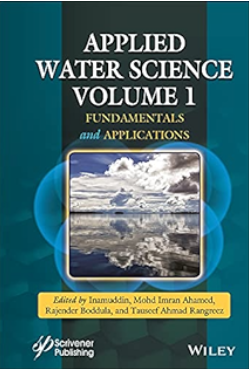气候变率和lulc变化下的水平衡动态——流域尺度评价
摘要
本研究的目的是开发一个能够模拟水平衡成分(wbc)的流域尺度水平衡模型,并特别关注数据稀疏环境。利用开放源代码的半分布式水文模型——水土评估工具(SWAT),通过整合年代际土地利用和土地覆盖(LULC)变化、日气象输入以及定常土壤和地形数据集,模拟了WBCs的动态。该模型模拟了月、年尺度上实际蒸散发、地表径流、侧流、渗滤和土壤含水量等关键wbc的时空分布。该模型框架应用于印度泰米尔纳德邦的Chittar流域,涵盖了20年的历史期(2001年1月至2020年12月)和30年的预测期(2021年1月至2050年12月)。使用swat -校准不确定度程序(SWAT-CUP)数据库,利用河表流量数据对模型进行了校准和验证。校正r方值为0.87,验证r方值为0.93。为了补充单变量校准(即出口的河表流量)并评估模型的一致性,使用全球土地蒸发阿姆斯特丹模型(GLEAM) v3.6a,对三个代表性子集水区的每月模拟声发射进行交叉验证。该验证得到的r平方值在子集水区的范围为0.78至0.82。这种双重验证策略通过确保流和ET动力学的空间一致性来增强模型的鲁棒性,解决了数据稀疏环境中固有的等价性问题。利用来自Landsat卫星图像的年代代史地图(2000年、2010年和2020年)整合了LULC动态,而利用元胞自动机(CA)-马尔可夫模型预测了未来情景(2030年、2040年和2050年)。历史上的每日气象资料来自Cheranmadevi天文台。基于代表性共同路径8.5 (Representative Common Pathways version 8.5, RCP 8.5)排放情景,利用ccc - cm项目数据剔除观测数据的偏差,重构了2022 - 2050年的未来日数据。在月、年尺度上通过强迫历史和未来LULC以及气象条件来模拟wbc。整个流域每10-15年就会出现一次极端气象事件。在2005年12月和2030年11月期间,超过60%的月降雨量转化为地表径流,反映了洪水风险的增加。AE表现出强烈的季节变率和3-4年的周期模式,预估表明,由于升温和LULC变化,未来时期AE的贡献略有增加。大约70%的年降雨量分为径流和AE,表明长期的水分损失加剧了干旱和洪水的脆弱性。降雨模式在地表径流、渗流和侧流中表现出快速响应,而西南和AE表现出滞后的水文响应,增加了水资源规划的复杂性。这些见解有助于决策者、研究人员和实践者在不断变化的气候和人为压力下制定气候适应战略和可持续的水资源和土地资源管理。The aim of this study was to develop a catchment scale water balance model capable of simulating water balance components (WBCs), with a specific focus on data-sparse environments. Using the Soil and Water Assessment Tool (SWAT), an open-source semi-distributed hydrological model, the WBCs dynamics simulated by integrating decadal land-use and land-cover (LULC) changes, daily meteorological inputs, and time-invariant soil and topography data sets. The model simulates the spatial and temporal distribution of key WBCs, including actual evapotranspiration (AE), surface runoff, lateral flow, percolation, and soil water content (SW) at monthly and annual scale. The model framework was applied to the Chittar catchment in Tamil Nadu, India, covering a 20 years historical period (January 2001–December 2020) and a 30 years forecast period (January 2021–December 2050). The model was calibrated and validated with river gauge discharge data using the SWAT-Calibration Uncertainty Procedures (SWAT-CUP) database. The R-square values were 0.87 for calibration and 0.93 for validation. To complement the single-variable calibration (i.e. river gauge discharge at the outlet) and assess model consistency, monthly simulated AE across three representative sub-catchments was cross-validated against gridded AE estimates using Global Land Evaporation Amsterdam Model (GLEAM) v3.6a. This validation yielded R-square values ranging from 0.78 to 0.82 across the sub-catchments. This dual validation strategy enhanced model robustness by ensuring spatial consistency in flow and ET dynamics, addressing equifinality concerns inherent in data-sparse environments. The LULC dynamics were incorporated using decadal historical maps (2000, 2010, 2020) derived from Landsat satellite imagery, while future scenarios (2030, 2040, 2050) were projected using the Cellular Automata (CA)-Markov model. Daily meteorological data for the historical were obtained from the Cheranmadevi observatory. The future daily data were reconstructed using Centro Euro-Mediterraneo sui Cambiamenti Climatici—Climate Model (CMCC-CM) project data based on the Representative Common Pathways version 8.5 (RCP 8.5) emission scenario from 2022 to 2050 after removing bias using observatory data. The WBCs were simulated by forcing historical and future LULC and meteorological conditions at monthly and annual scale. Meteorological extremes recurred every 10–15 years across the catchment. During December 2005 and November 2030, over 60% of monthly rainfall was converted to surface runoff, reflecting heightened flood risks. The AE exhibited strong seasonal variability and a 3–4 years cyclic pattern, with projections suggesting marginally increased contributions in future periods due to warming and LULC changes. Approximately 70% of annual rainfall partitioned into runoff and AE, indicating chronic water losses that amplify drought and flood vulnerabilities. Rainfall patterns showed a rapid response in surface runoff, percolation, and lateral flow, while SW and AE exhibited lagged hydrological responses, adding complexity to water resource planning. These insights aid policymakers, researchers, and practitioners in strategizing climate adaptation and sustainable management of water and land resources under shifting climatic and anthropogenic pressures.

 求助内容:
求助内容: 应助结果提醒方式:
应助结果提醒方式:


